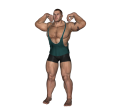 Elbow Circles - Fundamental
Elbow Circles - Fundamental
Benefits: This exercise tones and tightens your upper arms and elbows.
Purpose: This exercise focuses on working the entire elbow joint and makes an excellent warm-up before any resistance or weigh training involving the elbows.
Beginner Elbows Traps Stretching Body Only Gym Home
General Info: Elbow Circles require little time, yet can give good benefits when done regularly. They can be done almost anywhere, without special equipment. The three heads of the deltoid muscles require regular movement to ensure their flexibility and mobility.
 Eye - Changing Vision
Eye - Changing Vision
Benefits: A lot of eye problems in later life are due to a loss of tone in the eye muscles. These muscles become rigid, and this loss of elasticity reduces the ability of the lens of the eye to focus at different distances. It also causes the eyesight to become weaker.
Purpose: In addition, any eye tension present will tend to produce a general feeling of tension, due to the eye's connection to the brain via the optic nerve. What happens is that eye tension produces an increase in the nerve impulses in the eye muscles. This increase in nerve impulses travels along the optic nerve and bombards the brain, causing a general feeling of tension and anxiety.
Beginner Eyes Body Only Home
General Info: We were born to have hunters' eyes, needed for spotting game or danger at a distance. But during the last 50 years nearly all our work and much of our recreation, for example, video games, has shifted the focus of our vision to arm's length. The increased amount of near visual tasks often produces such changes as nearsightedness, suppressed vision in one eye, poor eye teaming and reduced efficiency at work and at play.
 Eye - Contraction
Eye - Contraction
Benefits: A lot of eye problems in later life are due to a loss of tone in the eye muscles. These muscles become rigid, and this loss of elasticity reduces the ability of the lens of the eye to focus at different distances. It also causes the eyesight to become weaker.
Purpose: In addition, any eye tension present will tend to produce a general feeling of tension, due to the eye's connection to the brain via the optic nerve. What happens is that eye tension produces an increase in the nerve impulses in the eye muscles. This increase in nerve impulses travels along the optic nerve and bombards the brain, causing a general feeling of tension and anxiety.
Beginner Eyes Body Only Home
General Info: We were born to have hunters' eyes, needed for spotting game or danger at a distance. But during the last 50 years nearly all our work and much of our recreation, for example, video games, has shifted the focus of our vision to arm's length. The increased amount of near visual tasks often produces such changes as nearsightedness, suppressed vision in one eye, poor eye teaming and reduced efficiency at work and at play.
 Eye - Corner To Corner
Eye - Corner To Corner
Benefits: A lot of eye problems in later life are due to a loss of tone in the eye muscles. These muscles become rigid, and this loss of elasticity reduces the ability of the lens of the eye to focus at different distances. It also causes the eyesight to become weaker.
Purpose: In addition, any eye tension present will tend to produce a general feeling of tension, due to the eye's connection to the brain via the optic nerve. What happens is that eye tension produces an increase in the nerve impulses in the eye muscles. This increase in nerve impulses travels along the optic nerve and bombards the brain, causing a general feeling of tension and anxiety.
Beginner Eyes Body Only Home
General Info: We were born to have hunters' eyes, needed for spotting game or danger at a distance. But during the last 50 years nearly all our work and much of our recreation, for example, video games, has shifted the focus of our vision to arm's length. The increased amount of near visual tasks often produces such changes as nearsightedness, suppressed vision in one eye, poor eye teaming and reduced efficiency at work and at play.
 Eye - Palming
Eye - Palming
Benefits: A lot of eye problems in later life are due to a loss of tone in the eye muscles. These muscles become rigid, and this loss of elasticity reduces the ability of the lens of the eye to focus at different distances. It also causes the eyesight to become weaker.
Purpose: In addition, any eye tension present will tend to produce a general feeling of tension, due to the eye's connection to the brain via the optic nerve. What happens is that eye tension produces an increase in the nerve impulses in the eye muscles. This increase in nerve impulses travels along the optic nerve and bombards the brain, causing a general feeling of tension and anxiety.
Beginner Eyes Body Only Home
General Info: We were born to have hunters' eyes, needed for spotting game or danger at a distance. But during the last 50 years nearly all our work and much of our recreation, for example, video games, has shifted the focus of our vision to arm's length. The increased amount of near visual tasks often produces such changes as nearsightedness, suppressed vision in one eye, poor eye teaming and reduced efficiency at work and at play.
 Eye - Rotation
Eye - Rotation
Benefits: A lot of eye problems in later life are due to a loss of tone in the eye muscles. These muscles become rigid, and this loss of elasticity reduces the ability of the lens of the eye to focus at different distances. It also causes the eyesight to become weaker.
Purpose: In addition, any eye tension present will tend to produce a general feeling of tension, due to the eye's connection to the brain via the optic nerve. What happens is that eye tension produces an increase in the nerve impulses in the eye muscles. This increase in nerve impulses travels along the optic nerve and bombards the brain, causing a general feeling of tension and anxiety.
Beginner Eyes Body Only Home
General Info: We were born to have hunters' eyes, needed for spotting game or danger at a distance. But during the last 50 years nearly all our work and much of our recreation, for example, video games, has shifted the focus of our vision to arm's length. The increased amount of near visual tasks often produces such changes as nearsightedness, suppressed vision in one eye, poor eye teaming and reduced efficiency at work and at play.
 Eye - Scanning
Eye - Scanning
Benefits: A lot of eye problems in later life are due to a loss of tone in the eye muscles. These muscles become rigid, and this loss of elasticity reduces the ability of the lens of the eye to focus at different distances. It also causes the eyesight to become weaker.
Purpose: In addition, any eye tension present will tend to produce a general feeling of tension, due to the eye's connection to the brain via the optic nerve. What happens is that eye tension produces an increase in the nerve impulses in the eye muscles. This increase in nerve impulses travels along the optic nerve and bombards the brain, causing a general feeling of tension and anxiety.
Beginner Eyes Body Only Home
General Info: We were born to have hunters' eyes, needed for spotting game or danger at a distance. But during the last 50 years nearly all our work and much of our recreation, for example, video games, has shifted the focus of our vision to arm's length. The increased amount of near visual tasks often produces such changes as nearsightedness, suppressed vision in one eye, poor eye teaming and reduced efficiency at work and at play.
 Eye - Side To Side
Eye - Side To Side
Benefits: A lot of eye problems in later life are due to a loss of tone in the eye muscles. These muscles become rigid, and this loss of elasticity reduces the ability of the lens of the eye to focus at different distances. It also causes the eyesight to become weaker.
Purpose: In addition, any eye tension present will tend to produce a general feeling of tension, due to the eye's connection to the brain via the optic nerve. What happens is that eye tension produces an increase in the nerve impulses in the eye muscles. This increase in nerve impulses travels along the optic nerve and bombards the brain, causing a general feeling of tension and anxiety.
Beginner Eyes Body Only Home
General Info: We were born to have hunters' eyes, needed for spotting game or danger at a distance. But during the last 50 years nearly all our work and much of our recreation, for example, video games, has shifted the focus of our vision to arm's length. The increased amount of near visual tasks often produces such changes as nearsightedness, suppressed vision in one eye, poor eye teaming and reduced efficiency at work and at play.
 Eye - Up And Down
Eye - Up And Down
Benefits: A lot of eye problems in later life are due to a loss of tone in the eye muscles. These muscles become rigid, and this loss of elasticity reduces the ability of the lens of the eye to focus at different distances. It also causes the eyesight to become weaker.
Purpose: In addition, any eye tension present will tend to produce a general feeling of tension, due to the eye's connection to the brain via the optic nerve. What happens is that eye tension produces an increase in the nerve impulses in the eye muscles. This increase in nerve impulses travels along the optic nerve and bombards the brain, causing a general feeling of tension and anxiety.
Beginner Eyes Body Only Home
General Info: We were born to have hunters' eyes, needed for spotting game or danger at a distance. But during the last 50 years nearly all our work and much of our recreation, for example, video games, has shifted the focus of our vision to arm's length. The increased amount of near visual tasks often produces such changes as nearsightedness, suppressed vision in one eye, poor eye teaming and reduced efficiency at work and at play.
 Eye - Writing
Eye - Writing
Benefits: A lot of eye problems in later life are due to a loss of tone in the eye muscles. These muscles become rigid, and this loss of elasticity reduces the ability of the lens of the eye to focus at different distances. It also causes the eyesight to become weaker.
Purpose: In addition, any eye tension present will tend to produce a general feeling of tension, due to the eye's connection to the brain via the optic nerve. What happens is that eye tension produces an increase in the nerve impulses in the eye muscles. This increase in nerve impulses travels along the optic nerve and bombards the brain, causing a general feeling of tension and anxiety.
Beginner Eyes Body Only Home
General Info: We were born to have hunters' eyes, needed for spotting game or danger at a distance. But during the last 50 years nearly all our work and much of our recreation, for example, video games, has shifted the focus of our vision to arm's length. The increased amount of near visual tasks often produces such changes as nearsightedness, suppressed vision in one eye, poor eye teaming and reduced efficiency at work and at play.
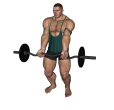 EZ Bar Curl - Basic
EZ Bar Curl - Basic
Benefits: This exercise puts the forearms in a stronger position, allowing you to lift heavier weights. The EZ Bar puts the hands in a very strong position.
Purpose: This exercise is used to target the biceps muscle to develop size, definition, strength, endurance and power.
Beginner Biceps Forearms Shoulders Strength EZ Bar Pull Gym
General Info: The biceps is a straight muscle with two heads. The long head of the biceps crosses both the elbow and the shoulder joint. It bends the elbow and raises the arm forward at the shoulder. The short head crosses the elbow joint and, in conjunction with the brachioradialis, supinates the hand.
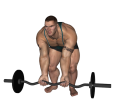 EZ Bar Curl - Bent Over
EZ Bar Curl - Bent Over
Benefits: This exercise is similar in effect to the Spider curl and does a good job of placing maximum tension on the biceps in the fully contracted position.
Purpose: This exercise works the biceps muscles but focuses also on the brachioradialis (a muscle that crosses the elbow joint and assists in rotating the forearm).
Beginner Biceps Forearms Shoulders Strength EZ Bar Pull Gym
General Info: The biceps is a straight muscle which has two heads. The long head crosses both the elbow and the shoulder joints. It bends the arm at the elbow and raises the arm forward at the shoulder. The short head crosses the elbow joint and, in conjunction with the brachioradialis, supinates the hand.
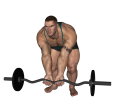 EZ Bar Curl - Bent Over Close Grip
EZ Bar Curl - Bent Over Close Grip
Benefits: This exercise is similar in effect to the Spider curl and does a good job of placing maximum tension on the biceps in the fully contracted position.
Purpose: This exercise works the biceps muscles but focuses also on the brachioradialis (a muscle that crosses the elbow joint and assists in rotating the forearm).
Beginner Biceps Forearms Shoulders Strength EZ Bar Pull Gym
General Info: The biceps is a straight muscle which has two heads. The long head crosses both the elbow and the shoulder joints. It bends the arm at the elbow and raises the arm forward at the shoulder. The short head crosses the elbow joint and, in conjunction with the brachioradialis, supinates the hand.
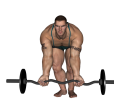 EZ Bar Curl - Bent Over Narrow Stance
EZ Bar Curl - Bent Over Narrow Stance
Benefits: This exercise is similar in effect to the Spider curl and does a good job of placing maximum tension on the biceps in the fully contracted position.
Purpose: This exercise works the biceps muscles but focuses also on the brachioradialis (a muscle that crosses the elbow joint and assists in rotating the forearm).
Beginner Biceps Forearms Shoulders Strength EZ Bar Pull Gym
General Info: The biceps is a straight muscle which has two heads. The long head crosses both the elbow and the shoulder joints. It bends the arm at the elbow and raises the arm forward at the shoulder. The short head crosses the elbow joint and, in conjunction with the brachioradialis, supinates the hand.
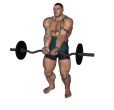 EZ Bar Curl - Close Grip
EZ Bar Curl - Close Grip
Benefits: This exercise works both heads of the biceps. The EZ Bar puts the hands in a very strong position.
Purpose: This exercise is used to target the biceps muscle to develop size, definition, strength, endurance and power.
Beginner Biceps Forearms Strength EZ Bar Pull Gym
General Info: The biceps is a straight muscle with two heads. The long head of the biceps crosses both the elbow and the shoulder joint. It bends the elbow and raises the arm forward at the shoulder. The short head crosses the elbow joint and, in conjunction with the brachioradialis, supinates the hand.
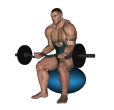 EZ Bar Curl - Fitness Ball
EZ Bar Curl - Fitness Ball
Benefits: This exercise puts the forearms in a stronger position, allowing you to lift heavier weights.
Purpose: This exercise is used to target the biceps muscle to develop size, definition, strength, endurance and power.
Beginner Biceps Forearms Shoulders Strength EZ Bar Fitness Ball Pull Gym
General Info: The biceps is a straight muscle with two heads. The long head of the biceps crosses both the elbow and the shoulder joint. It bends the elbow and raises the arm forward at the shoulder. The short head crosses the elbow joint and, in conjunction with the brachioradialis, supinates the hand.
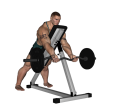 EZ Bar Curl - Overhang
EZ Bar Curl - Overhang
Benefits: This exercise is similar in effect to the Spider curl and does a good job of placing maximum tension on the biceps in the fully contracted position.
Purpose: This exercise works the biceps muscles.
Beginner Biceps Strength Barbell Incline Bench Pull Gym
General Info: The biceps muscle is a straight muscle with 2 heads. The long head crosses both the elbow and shoulder joints and bends the elbow and raises the arm forward at the shoulder. The short head of the biceps crosses the elbow joint and, in conjunction with the brachioradialis, supinates the hand.
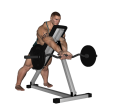 EZ Bar Curl - Overhang Close Grip
EZ Bar Curl - Overhang Close Grip
Benefits: This exercise is similar in effect to the Spider curl and does a good job of placing maximum tension on the biceps in the fully contracted position.
Purpose: This exercise works the biceps muscles.
Beginner Biceps Strength EZ Bar Incline Bench Pull Gym
General Info: The biceps muscle is a straight muscle with 2 heads. The long head crosses both the elbow and shoulder joints and bends the elbow and raises the arm forward at the shoulder. The short head of the biceps crosses the elbow joint and, in conjunction with the brachioradialis, supinates the hand.
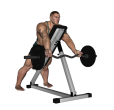 EZ Bar Curl - Overhang Wide Grip
EZ Bar Curl - Overhang Wide Grip
Benefits: This exercise is similar in effect to the Spider curl and does a good job of placing maximum tension on the biceps in the fully contracted position.
Purpose: This exercise works the biceps muscles.
Beginner Biceps Strength EZ Bar Incline Bench Pull Gym
General Info: The biceps muscle is a straight muscle with 2 heads. The long head crosses both the elbow and shoulder joints and bends the elbow and raises the arm forward at the shoulder. The short head of the biceps crosses the elbow joint and, in conjunction with the brachioradialis, supinates the hand.
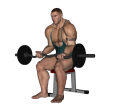 EZ Bar Curl - Seated
EZ Bar Curl - Seated
Benefits: This exercise isolates the biceps so that momentum does not come into play.
Purpose: This exercise strengthens the biceps.
Beginner Biceps Forearms Shoulders Traps Strength EZ Bar Flat Bench Pull Gym
General Info: The biceps muscle is a straight muscle with 2 heads. The long head crosses both the elbow and shoulder joints and bends the elbow and raises the arm forward at the shoulder. The short head of the biceps crosses the elbow joint and, in conjunction with the brachioradialis, supinates the hand..
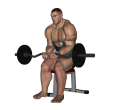 EZ Bar Curl - Seated Close Grip
EZ Bar Curl - Seated Close Grip
Benefits: This exercise isolates the biceps so that momentum does not come into play.
Purpose: This exercise strengthens the biceps.
Beginner Biceps Forearms Shoulders Traps Strength EZ Bar Flat Bench Pull Gym
General Info: The biceps muscle is a straight muscle with 2 heads. The long head crosses both the elbow and shoulder joints and bends the elbow and raises the arm forward at the shoulder. The short head of the biceps crosses the elbow joint and, in conjunction with the brachioradialis, supinates the hand..
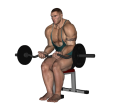 EZ Bar Curl - Seated Close Narrow
EZ Bar Curl - Seated Close Narrow
Benefits: This exercise isolates the biceps so that momentum does not come into play.
Purpose: This exercise strengthens the biceps.
Beginner Biceps Forearms Shoulders Traps Strength EZ Bar Flat Bench Pull Gym
General Info: The biceps muscle is a straight muscle with 2 heads. The long head crosses both the elbow and shoulder joints and bends the elbow and raises the arm forward at the shoulder. The short head of the biceps crosses the elbow joint and, in conjunction with the brachioradialis, supinates the hand..
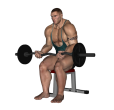 EZ Bar Curl - Seated Feet Up
EZ Bar Curl - Seated Feet Up
Benefits: This exercise isolates the biceps so that momentum does not come into play.
Purpose: This exercise strengthens the biceps.
Beginner Biceps Forearms Shoulders Traps Strength EZ Bar Flat Bench Pull Gym
General Info: The biceps muscle is a straight muscle with 2 heads. The long head crosses both the elbow and shoulder joints and bends the elbow and raises the arm forward at the shoulder. The short head of the biceps crosses the elbow joint and, in conjunction with the brachioradialis, supinates the hand..
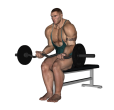 EZ Bar Curl - Seated Narrow Stance
EZ Bar Curl - Seated Narrow Stance
Benefits: This exercise isolates the biceps so that momentum does not come into play.
Purpose: This exercise strengthens the biceps.
Beginner Biceps Forearms Shoulders Traps Strength EZ Bar Flat Bench Pull Gym
General Info: The biceps muscle is a straight muscle with 2 heads. The long head crosses both the elbow and shoulder joints and bends the elbow and raises the arm forward at the shoulder. The short head of the biceps crosses the elbow joint and, in conjunction with the brachioradialis, supinates the hand..
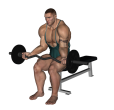 EZ Bar Curl - Seated Wide Grip
EZ Bar Curl - Seated Wide Grip
Benefits: This exercise isolates the biceps so that momentum does not come into play. The EZ Bar puts the hands in a very strong position.
Purpose: This exercise strengthens the biceps.
Beginner Biceps Forearms Shoulders Traps Strength EZ Bar Flat Bench Pull Gym
General Info: The biceps muscle is a straight muscle with 2 heads. The long head crosses both the elbow and shoulder joints and bends the elbow and raises the arm forward at the shoulder. The short head of the biceps crosses the elbow joint and, in conjunction with the brachioradialis, supinates the hand..
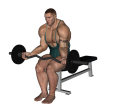 EZ Bar Curl - Seated Wide Narrow
EZ Bar Curl - Seated Wide Narrow
Benefits: This exercise isolates the biceps so that momentum does not come into play.
Purpose: This exercise strengthens the biceps.
Beginner Biceps Forearms Shoulders Traps Strength EZ Bar Flat Bench Pull Gym
General Info: The biceps muscle is a straight muscle with 2 heads. The long head crosses both the elbow and shoulder joints and bends the elbow and raises the arm forward at the shoulder. The short head of the biceps crosses the elbow joint and, in conjunction with the brachioradialis, supinates the hand..
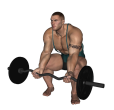 EZ Bar Curl - Squat
EZ Bar Curl - Squat
Benefits: This exercise isolates the biceps so that momentum does not come into play.
Purpose: This exercise strengthens the biceps.
Intermediate Biceps Forearms Shoulders Traps Strength EZ Bar Pull Gym
General Info: The biceps muscle is a straight muscle with 2 heads. The long head crosses both the elbow and shoulder joints and bends the elbow and raises the arm forward at the shoulder. The short head of the biceps crosses the elbow joint and, in conjunction with the brachioradialis, supinates the hand..
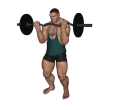 EZ Bar Curl - Standing
EZ Bar Curl - Standing
Benefits: This exercise puts the forearms in a stronger position, allowing you to lift heavier weights.
Purpose: This exercise is used to target the biceps muscle to develop size, definition, strength, endurance and power.
Beginner Biceps Forearms Shoulders Strength EZ Bar Pull Gym
General Info: The biceps is a straight muscle with two heads. The long head of the biceps crosses both the elbow and the shoulder joint. It bends the elbow and raises the arm forward at the shoulder. The short head crosses the elbow joint and, in conjunction with the brachioradialis, supinates the hand.
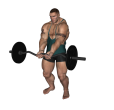 EZ Bar Curl - Standing Close Grip
EZ Bar Curl - Standing Close Grip
Benefits: This exercise puts the forearms in a stronger position, allowing you to lift heavier weights.
Purpose: This exercise is used to target the biceps muscle to develop size, definition, strength, endurance and power.
Beginner Biceps Forearms Shoulders Strength EZ Bar Pull Gym
General Info: The biceps is a straight muscle with two heads. The long head of the biceps crosses both the elbow and the shoulder joint. It bends the elbow and raises the arm forward at the shoulder. The short head crosses the elbow joint and, in conjunction with the brachioradialis, supinates the hand.
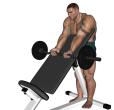 EZ Bar Curl - Standing Incline
EZ Bar Curl - Standing Incline
Benefits: This exercise works both heads of the biceps with a heavier weight than can typically be done with dumbbells.
Purpose: This exercise is used to target the biceps muscle to develop size, definition, strength, endurance and power.
Beginner Biceps Forearms Shoulders Strength EZ Bar Incline Bench Pull Gym
General Info: The biceps is a straight muscle with two heads. The long head of the biceps crosses both the elbow and the shoulder joint. It bends the elbow and raises the arm forward at the shoulder. The short head crosses the elbow joint and, in conjunction with the brachioradialis, supinates the hand.
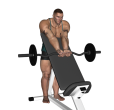 EZ Bar Curl - Standing Incline Close Grip
EZ Bar Curl - Standing Incline Close Grip
Benefits: This exercise works both heads of the biceps with a heavier weight than can typically be done with dumbbells.
Purpose: This exercise is used to target the biceps muscle to develop size, definition, strength, endurance and power.
Beginner Biceps Forearms Shoulders Strength EZ Bar Incline Bench Pull Gym
General Info: The biceps is a straight muscle with two heads. The long head of the biceps crosses both the elbow and the shoulder joint. It bends the elbow and raises the arm forward at the shoulder. The short head crosses the elbow joint and, in conjunction with the brachioradialis, supinates the hand.
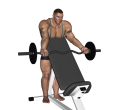 EZ Bar Curl - Standing Incline Wide Grip
EZ Bar Curl - Standing Incline Wide Grip
Benefits: This exercise works both heads of the biceps with a heavier weight than can typically be done with dumbbells.
Purpose: This exercise is used to target the biceps muscle to develop size, definition, strength, endurance and power.
Beginner Biceps Forearms Shoulders Strength EZ Bar Incline Bench Pull Gym
General Info: The biceps is a straight muscle with two heads. The long head of the biceps crosses both the elbow and the shoulder joint. It bends the elbow and raises the arm forward at the shoulder. The short head crosses the elbow joint and, in conjunction with the brachioradialis, supinates the hand.
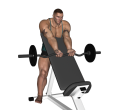 EZ Bar Curl - Standing Incline Wide Stance
EZ Bar Curl - Standing Incline Wide Stance
Benefits: This exercise works both heads of the biceps with a heavier weight than can typically be done with dumbbells.
Purpose: This exercise is used to target the biceps muscle to develop size, definition, strength, endurance and power.
Beginner Biceps Forearms Shoulders Strength EZ Bar Incline Bench Pull Gym
General Info: The biceps is a straight muscle with two heads. The long head of the biceps crosses both the elbow and the shoulder joint. It bends the elbow and raises the arm forward at the shoulder. The short head crosses the elbow joint and, in conjunction with the brachioradialis, supinates the hand.
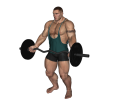 EZ Bar Curl - Standing Wide Grip
EZ Bar Curl - Standing Wide Grip
Benefits: This exercise puts the forearms in a stronger position, allowing you to lift heavier weights.
Purpose: This exercise is used to target the biceps muscle to develop size, definition, strength, endurance and power.
Beginner Biceps Forearms Shoulders Strength EZ Bar Pull Gym
General Info: The biceps is a straight muscle with two heads. The long head of the biceps crosses both the elbow and the shoulder joint. It bends the elbow and raises the arm forward at the shoulder. The short head crosses the elbow joint and, in conjunction with the brachioradialis, supinates the hand.
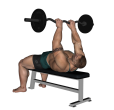 EZ Bar Press - Flat Bench Close Grip
EZ Bar Press - Flat Bench Close Grip
Benefits: This exercise works both heads of the triceps with a heavier weight than can typically be done with dumbbells.
Purpose: This exercise is used to target the triceps muscle to develop size, definition, strength, endurance and power.
Beginner Triceps Chest Shoulders Strength EZ Bar Flat Bench Push Compound Gym
General Info: The triceps is a straight muscle with three heads. The long head straightens the elbow, adducts the shoulder (brings it from a side position to the body) and extends the shoulder (brings the arm from a front position down to the body). The lateral head (outer head) straightens the elbow. The medial head also straightens the elbow.
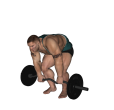 EZ Bar Row - Basic
EZ Bar Row - Basic
Benefits: This exercise is a strong, effective free weight back exercise for building muscle mass and size of the lats.
Purpose: This is a good exercise for increasing strength and size in the upper back.
Intermediate Traps Lats Triceps Posterior Delts Strength EZ Bar Pull Compound Gym
General Info: There are a number of muscles in the back, although the two major muscles are the lats and traps. The lats pulls the arm back and down towards the spine. The traps pull the shoulder blades back and towards the spine.
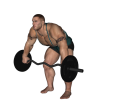 EZ Bar Row - Basic Wide Grip
EZ Bar Row - Basic Wide Grip
Benefits: This exercise is a strong, effective free weight back exercise for building muscle mass and size of the lats.
Purpose: This is a good exercise for increasing strength and size in the upper back.
Intermediate Traps Lats Triceps Posterior Delts Strength EZ Bar Pull Compound Gym
General Info: There are a number of muscles in the back, although the two major muscles are the lats and traps. The lats pulls the arm back and down towards the spine. The traps pull the shoulder blades back and towards the spine.
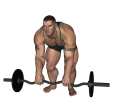 EZ Bar Row - Bent Over
EZ Bar Row - Bent Over
Benefits: This exercise is a strong, effective free weight back exercise for building muscle mass and size of the lats.
Purpose: This is a good exercise for increasing strength and size in the upper back.
Intermediate Traps Lats Triceps Posterior Delts Strength EZ Bar Pull Compound Gym
General Info: There are a number of muscles in the back, although the two major muscles are the lats and traps. The lats pulls the arm back and down towards the spine. The traps pull the shoulder blades back and towards the spine.
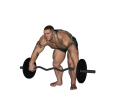 EZ Bar Row - Bent Over Wide Grip
EZ Bar Row - Bent Over Wide Grip
Benefits: This exercise is a strong, effective free weight back exercise for building muscle mass and size of the lats.
Purpose: This is a good exercise for increasing strength and size in the upper back.
Intermediate Traps Lats Triceps Posterior Delts Strength EZ Bar Pull Compound Gym
General Info: There are a number of muscles in the back, although the two major muscles are the lats and traps. The lats pulls the arm back and down towards the spine. The traps pull the shoulder blades back and towards the spine.
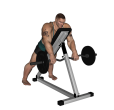 EZ Bar Row - Incline Bench
EZ Bar Row - Incline Bench
Benefits: This exercise is a strong, effective free weight back exercise for building muscle mass and size of the lats.
Purpose: This is a good exercise for increasing strength and size in the upper back.
Intermediate Traps Lats Triceps Posterior Delts Strength EZ Bar Incline Bench Pull Compound Gym
General Info: There are a number of muscles in the back, although the two major muscles are the lats and traps. The lats pulls the arm back and down towards the spine. The traps pull the shoulder blades back and towards the spine.
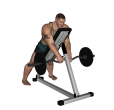 EZ Bar Row - Incline Close Grip
EZ Bar Row - Incline Close Grip
Benefits: This exercise is a strong, effective free weight back exercise for building muscle mass and size of the lats.
Purpose: This is a good exercise for increasing strength and size in the upper back.
Intermediate Traps Lats Triceps Posterior Delts Strength EZ Bar Incline Bench Pull Compound Gym
General Info: There are a number of muscles in the back, although the two major muscles are the lats and traps. The lats pulls the arm back and down towards the spine. The traps pull the shoulder blades back and towards the spine.
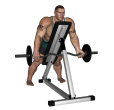 EZ Bar Row - Incline Mixed Grip
EZ Bar Row - Incline Mixed Grip
Benefits: This exercise is a strong, effective free weight back exercise for building muscle mass and size of the lats.
Purpose: This is a good exercise for increasing strength and size in the upper back.
Intermediate Traps Lats Triceps Posterior Delts Strength EZ Bar Incline Bench Pull Compound Gym
General Info: There are a number of muscles in the back, although the two major muscles are the lats and traps. The lats pulls the arm back and down towards the spine. The traps pull the shoulder blades back and towards the spine.
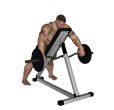 EZ Bar Row - Incline Wide Grip
EZ Bar Row - Incline Wide Grip
Benefits: This exercise is a strong, effective free weight back exercise for building muscle mass and size of the lats.
Purpose: This is a good exercise for increasing strength and size in the upper back.
Intermediate Traps Lats Triceps Posterior Delts Strength EZ Bar Incline Bench Pull Compound Gym
General Info: There are a number of muscles in the back, although the two major muscles are the lats and traps. The lats pulls the arm back and down towards the spine. The traps pull the shoulder blades back and towards the spine.
Could not find your favorite exercise in the list? Please start a discussion and post the name and the list of steps. We will try to add it as soon as we can.